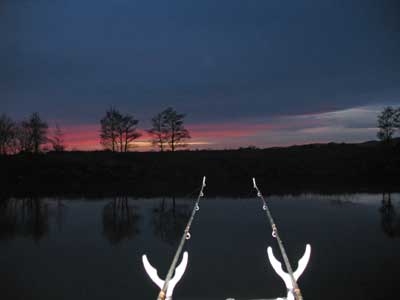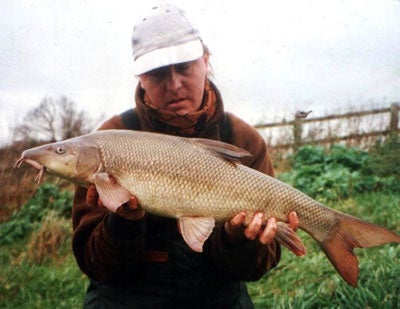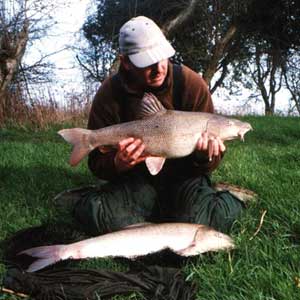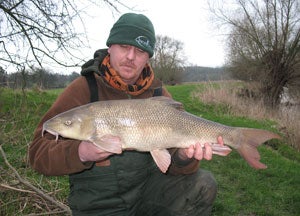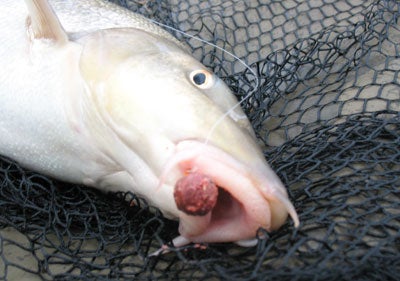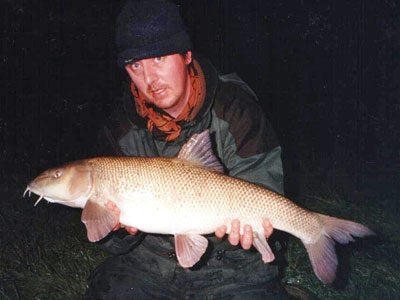Wanderering About Barbel
I suppose one of the main things that differentiates river fishing for barbel from, say, stillwater carp fishing is the fact that in many cases no two seasons are the same regarding fish stocks. Now don’t get me wrong, I do like my carp fishing and up until ten or twelve years ago I used to fish for them throughout the year. The thing with most carp waters is that after a season or two it soon becomes apparent what the fish stocks are and, unless fish get stolen or you get the odd new fish coming through, these stocks are not going to change. Obviously this is not the case with river barbel as they are free to wander wherever they want to. Stretches can vary from year to year My barbel fishing last year really brought home to me the way certain stretches can vary from year to year. I usually start my barbel fishing around October onwards, preferring to fish for other species for the rest of the year (which I believe keeps your fishing from getting ‘stale’ – variety is the spice of life and all that!). Last Autumn / Winter I fished the Lower Severn, the Upper Trent, the Warwickshire Avon and the river Dove and on all of these rivers the barbel stocks were significantly different to previous seasons. The stock was totally different to previous seasons on the stretches I fished on the Lower Severn and Warwickshire Avon. On one of the stretches on the Lower Severn I got to know well over the last few seasons there seemed to be a sudden influx of smaller fish; in fact five trips (approximately seven hours each) produced 25 fish with only one double of 10lb 3oz amongst them. Now bear in mind that over the last few seasons, after getting to know the stretch, I had averaged a double roughly every two and half trips. Conversely on another stretch, which is only four miles downstream, there were next to no fish. In fact in six trips I only caught one small barbel of about a pound and the local anglers who fished the stretch regularly didn’t fare any better.
The Warwickshire Avon We did however fair much better on the stretch of the Warwickshire Avon that we fished. I first fished this stretch in February 2002 and apart from the one day when I had six fished topped off by a cracker of 12lb 5oz we never caught more than one or two fish per day. The 12lb fish and another of 10lb+ were also caught by other anglers that I knew, so it would suggest that there were not many fish there. We only revisited it last year in January. We had planned to fish the Lower Severn but when driving down we could see that the flooding was that bad that the Severn had actually joined the Teme. From experience I knew that the Avon would probably be fishable. In fact in certain situations when it is in flood it is actually easier to fish as it tends to ‘back up’, especially if you are fishing not too far below a weir. The river was into the fields and only a couple of pegs were fishable. However I did manage nice fish of 11lb 3oz and 11lb 1oz. This was the start of some of the most productive barbel fishing I have had and with very good average size fish as my diary entries below show: 12th Jan: 11lb 3oz & 11lb 1oz My good mate Geoff Dace also had fish of 12lb 14oz and 12lb 12oz. So in eight afternoons we had caught ten doubles plus some decent back-up fish. All of the double figure fish were different fish. So obviously there were numbers of good average sized fish on this stretch and if we had been put off by previous season’s results we would have missed out on them. The fish were caught from the same couple of swims and in both low and high water conditions. So you couldn’t put the number of fish down to the river conditions they just stayed put for that period of time. This stretch has again changed this season. I blanked the first couple of trips and then on the third trip had fish of 7lb 8oz, 10lb 6oz and 10lb 10oz. Geoff has yet to have a bite and the locals are really struggling. Although I do believe that most of the Avon has fished poorly which could be an adverse affect of the extreme summer flooding. So I would suggest that with these two rivers it really does pay to try different area’s and not just to stick to the same old couple of swims year in year out.
But what causes these changes in barbel population in these particular rivers? It’s certainly not down to ‘angler pressure’ as the stretches that I fish don’t see that many people and especially at the time of year I fish (autumn / winter). It’s not down to predation as has occurred on some of the southern rivers. I have seen an otter on both the Avon and the Severn but only on a couple of occasions and have never really seen any sign of dead fish left by them. I personally believe that when the barbel have left their spawning ground they will wander about until they find an area which they will favour. This could be down to the amount of natural food in a particular area, movement of underwater snags, gravel runs / silt, etc. Or in the case of the bigger fish it could be the fact that they will not want to share an area with too many smaller fish, as this is all competition for food. They will then very often ‘over-winter’ there until it is time for them to move back to the spawning ground again. Although obviously certain fish will still move about during the winter most of them seem to stay put. If you fish a stretch a number of times with a group of mates you will prove this to yourself as you will find that after a while you will be seeing repeat captures between your group. Quest Baits Last winter was the first time I had used the Quest baits boilies for barbel fishing. Quest baits is run by Shaun Harrison, a very experienced carp angler. Shaun has put together a really good package of high quality baits. I had used them for carp fishing both at home and abroad and had good success with them and so decided to try them for the barbel. I used the Special Crab frozen boiles and matching paste. You only have to smell this bait and you know it is going to be a good fish catcher. I used them in conjunction with a large modified Drennan oval feeder, which was usually filled with 4mm pellets. All of the fish I caught from the Avon and 90% of the other fish from last winter were caught on this bait / method and with no pre-baiting.
The DoveThe stretch of the Dove that Geoff and myself have fished over the last couple of winters is a very well known big fish stretch. This is another stretch that has certainly changed as regards to its barbel numbers. When Geoff was fishing this stretch regularly four or five years ago he was catching a fish roughly every five or six hours as I believe plenty of other people were. Because of the size that the fish have reached on this stretch this has led to more and more anglers fishing for them. The fishing has now become what I call ‘pot luck’ fishing. I have fished this stretch fourteen times with Geoff over the last two winters and caught one barbel of 12lb 12oz and a couple of fair sized chub. Geoff has had one barbel at 9lb+ and two or three chub. Apart from these fish there have only been two other barbel caught whilst we have been fishing. Because of the much increased angler pressure I believe that a lot of these fish have moved to other nearby quieter stretches. This movement has led to more double figured fish being caught off these other stretches. The few fish that are left on the better-known area have since faced far less competition for food and so stay where they are, growing bigger season after season. There are four really big fish left along with the odd few back-up doubles and small fish, but very little else. Don’t be fooled by the few big fish that you see in the press from this river. They are often repeat captures and often by people who fish the same small stretch almost every night of the week. Even by fishing this often these guys can still go a month without a fish. When you consider that this stretch has no more that about fifteen pegs you can see why I call it ‘pot luck’ fishing. You may just be lucky that one of the big fish is in your swim and feeding while you are there. The numbers of anglers present also makes the fishing harder. I have been fishing on a weekend on a couple of occasions and seen situations such as four or five anglers having up to ten rods fishing in about fifty yards of water. You stand little chance of catching one of these pressurised fish by fishing like this. More often than not these fish are caught when anglers are fishing on their own or there are very few other anglers fishing the stretch. It reminds me of when I used to fish the Church Pool on the Patshull Park Estate for carp some twenty years ago. This water is roughly eight acres. Now once the fish had all been caught a few times if there were more that half a dozen anglers on at a weekend it was very rare if anything was caught. Yet mid week when there was hardly anybody was there the fish would come out.
I haven’t fished the upper Trent that much, but from what I can gather the fish can be very nomadic with big fish turning up at anytime and almost anywhere. I have known people fish a certain stretch regularly for a couple of seasons catching nothing but chub then all of a sudden out of the blue they have caught a couple of really big fish. They then go back to just catching chub. This has happened to two anglers that I know fishing two different stretches and on each occasion the fish have only stayed around for a week or so. My own limited experience has shown a similar pattern. I have fished two different stretches. The one area produced four different doubles and a few back-up fish in six trips. The other stretch only produced a couple of chub in six trips. So to conclude I would say that if you are fishing a stretch of a river in good conditions and you have a period of sessions where you are not catching when you know that you should be, then it could well be time to try somewhere else as the chances are the barbel are not where you are. If you try and familiarise yourself with a few different stretches on a few different rivers the effort will prove well worthwhile as you will give yourself far more options. |
Welcome!Log into your account










